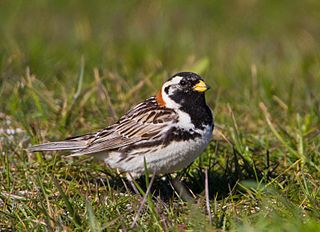
Wolf spiders are members of the family Lycosidae, from the Ancient Greek word "λύκος" meaning "wolf". They are robust and agile hunters with excellent eyesight. They live mostly in solitude and hunt alone, and do not spin webs. Some are opportunistic hunters pouncing upon prey as they find it or even chasing it over short distances. Some wait for passing prey in or near the mouth of a burrow.

Jumping spiders or the Salticidae are a family of spiders. As of 2019, it contained over 600 described genera and over 6000 described species, making it the largest family of spiders at 13% of all species. Jumping spiders have some of the best vision among arthropods and use it in courtship, hunting, and navigation. Although they normally move unobtrusively and fairly slowly, most species are capable of very agile jumps, notably when hunting, but sometimes in response to sudden threats or crossing long gaps. Both their book lungs and tracheal system are well-developed, and they use both systems. Jumping spiders are generally recognized by their eye pattern. All jumping spiders have four pairs of eyes, with the anterior median pair being particularly large.

Huntsman spiders, members of the family Sparassidae, are known by this name because of their speed and mode of hunting. They are also called giant crab spiders because of their size and appearance. Larger species sometimes are referred to as wood spiders, because of their preference for woody places. In southern Africa the genus Palystes are known as rain spiders or lizard-eating spiders. Commonly they are confused with baboon spiders from the Mygalomorphae infraorder, which are not closely related.

The Lapland longspur, also known as the Lapland bunting, is a passerine bird in the longspur family Calcariidae, a group separated by most modern authors from the Fringillidae.

Pellenes is a genus of jumping spiders that was first described by Eugène Louis Simon in 1876. It is considered a senior synonym of Hyllothyene.

Tarantulas comprise a group of large and often ″hairy″ spiders of the family Theraphosidae. Currently, about 1,000 species have been identified. The term tarantula is usually used to describe members of the family Theraphosidae, although many other members of the same infraorder (Mygalomorphae) are commonly referred to as "tarantulas" or "false tarantulas". Some of the more common species have become popular in the exotic pet trade. Many New World species kept as pets have urticating hairs that can cause irritation to the skin, and in extreme cases, cause damage to the eyes.

Bombus lapponicus is a species of bumblebee. It is native to northern Europe, where it occurs in Finland, Norway, Sweden, and Russia.

Spiders are air-breathing arthropods that have eight legs, chelicerae with fangs generally able to inject venom, and spinnerets that extrude silk. They are the largest order of arachnids and rank seventh in total species diversity among all orders of organisms. Spiders are found worldwide on every continent except for Antarctica, and have become established in nearly every habitat with the exceptions of air and sea colonization. As of July 2019, at least 48,200 spider species, and 120 families have been recorded by taxonomists. However, there has been dissension within the scientific community as to how all these families should be classified, as evidenced by the over 20 different classifications that have been proposed since 1900.

Pellenes seriatus is a species of 'jumping spiders' belonging to the family Salticidae.
Semljicola is a genus of sheet weavers that was first described by Embrik Strand in 1906.
Semljicola alticola is a spider species found in Sweden, Finland and Russia.
Semljicola angulatus is a spider species found in Scandinavia, Russia, Mongolia and Sakhalin.
Semljicola caliginosus is a spider species found in England, Scotland and Russia.
Semljicola latus is a spider species found in Scandinavia, Russia and Mongolia.

Kålhuvudet or the Kålhuvudets Nature Reserve is situated in Örnsköldsvik Municipality, in Björna parish of Västernorrland County in northern Sweden. It is located 7 km southwest of Hemling and covers 770 hectares.

Ectobius lapponicus is a species in the order Blattodea, in the class Insecta ("insects"). A common name for Ectobius lapponicus is "dusky cockroach".
Helophilus lapponicus is a species of syrphid fly in the family Syrphidae. It is found in Europe.

Thanatophilus lapponicus, the northern carrion beetle, is a species of carrion beetle in the family Silphidae. It is found in Europe & Northern Asia, Central America, and North America.
Cryptophagus lapponicus is a species of silken fungus beetle in the family Cryptophagidae. It is found in Europe & Northern Asia and North America.
Rumex lapponicus, known commonly as Lapland mountain sorrel is a perennial flowering herb species in the family Polygonaceae. It is commonly found in meadows and rock outcrops, as well as montane, arenicolous, and alluvial habitats.











